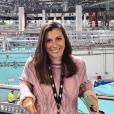
Showing 1321 - 1340 of 2566 results
ANSTO inspires young women into STEM careers
To celebrate International Women’s Day, ANSTO opened its doors to more than 50 female STEM students who heard from two accomplished ANSTO’s female scientists and STEM champions.

Understanding the full impact of radiation on astronauts
In space, without the protection of the magnetosphere, the type and dose of radiation is considerably different to what is naturally experienced on earth. However, it is the secondary particles of lower energies created when galactic and cosmic radiation interacts with shielding that is of concern for astronauts.
New advanced material shows extraordinary stability over wide temperature range
Researchers from UNSW have found an extraordinary material that does expand or contract over an extremely wide temperature range and may be one of the most stable materials known.

Highlights - Water Isotope Network
Highlights on the Water Isotope Network project.
Biking for research

Highlights - Planetary Materials
Planetary science is an emerging research theme in Australia, and research at ANSTO is embedded in the heart of this.
Scientist awarded for work probing nanoscale magnetic structures in thin films using neutron scattering
Simulating phase transformations during the welding of ferritic steels
New class of hydrogen conductors for industry
New class of conducting materials found for potential use in next generation fuel cells and other applications.
Graduate Profile – Vienna Wong
PhD candidate Vienna Wong is using her FutureNow Scholarship to research ultra-high temperature ceramics, which are emerging materials for extreme environments.

Role at ANSTO

Role at ANSTO

Highlights - Magnetism
Highlights of the Magnetism Project.

Understanding organic solar cells
The design and implementation of alternative energy sources is one of the greatest scientific and social challenges of our time.
Industry Access - Lucas Heights
ANSTO’s Lucas Heights campus has an extensive range of specialised facilities and capabilities that are available to assist industry-based professionals in solving problems. Please contact us to discuss how we can assist you. We are open to entering into commercial arrangement with appropriate partners.
Project BRIGHT
The BRIGHT Project will expand the beamline infrastructure of the Australian Synchrotron to increase both its capacity and capabilities.

High-energy heavy ion microprobe
The high-energy heavy-ion microprobe is used for the characterisation or modification of material properties at depths from approximately 1 micrometre to maximum depths of up to 500 micrometres from the material surface.